Parish Council Leisure
Frenchay
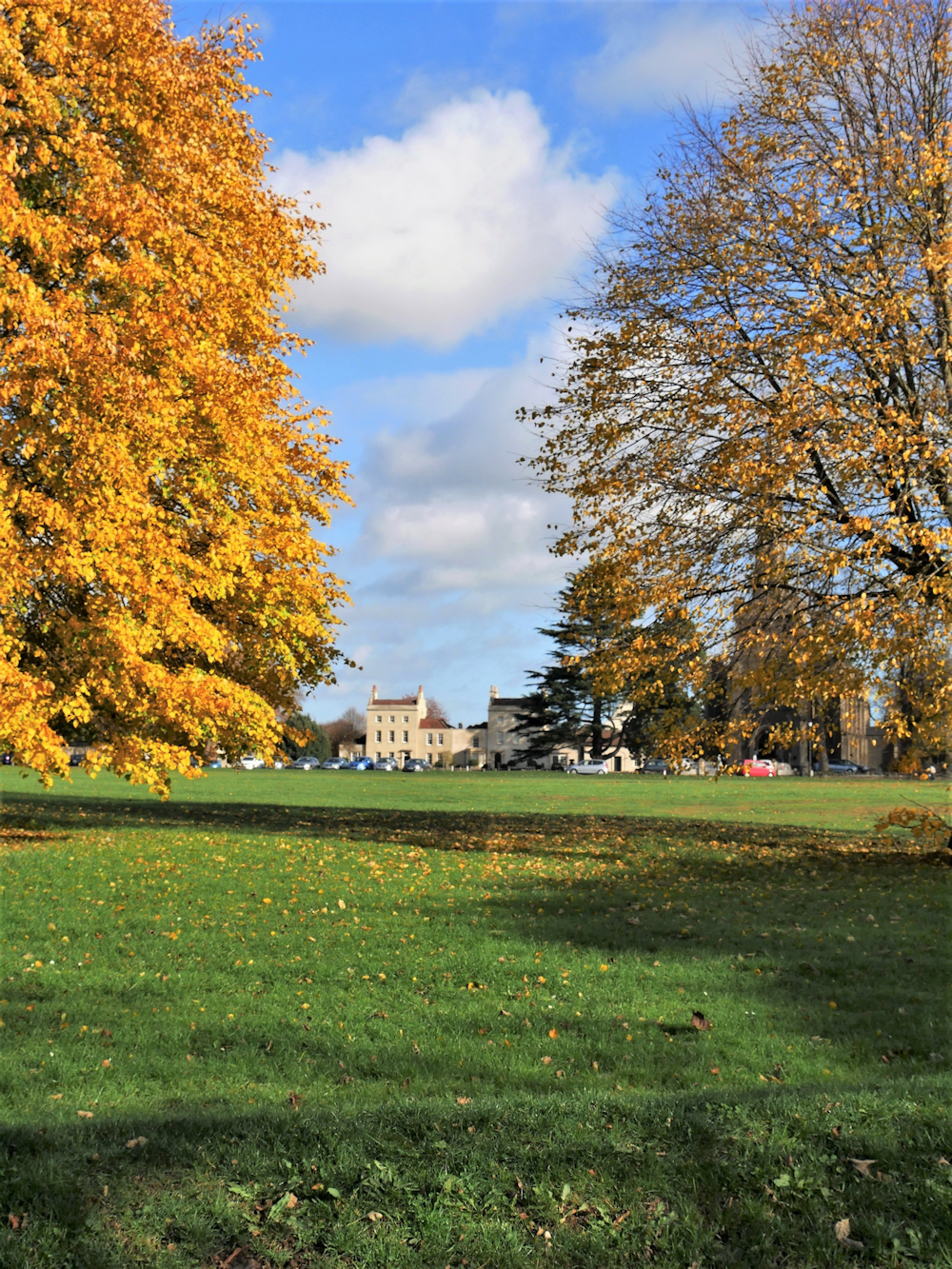
Frenchay Common
Much of the shape and history of this space is bound up with the gradual enclosure, legally or otherwise, of this particular Common.
A large part of the existing Common was quarried – that the rest was not and the filling in of the old quarry holes were due mainly to the passion for cricket which was avidly played from the early 19th century. Frenchay Cricket Club played here from 1846 to 1950 and the Grace family were closely connected with the Club.
- The annual Frenchay Flower Show
- The Cricket Day
- During the season it is also a host for junior football teams. Frenchay Primary School situated on the Common has no playing fields and regularly uses the abutting land for sport.
They also hold their annual Sports Day on this site. These activities in no way intrude on other informal uses of the Common by the local community, ie walkers, joggers, dog walkers and other games. The Parish church of St John also makes regular use of the Common. Frenchay Common is registered with Natural England (previously The Countryside Agency).
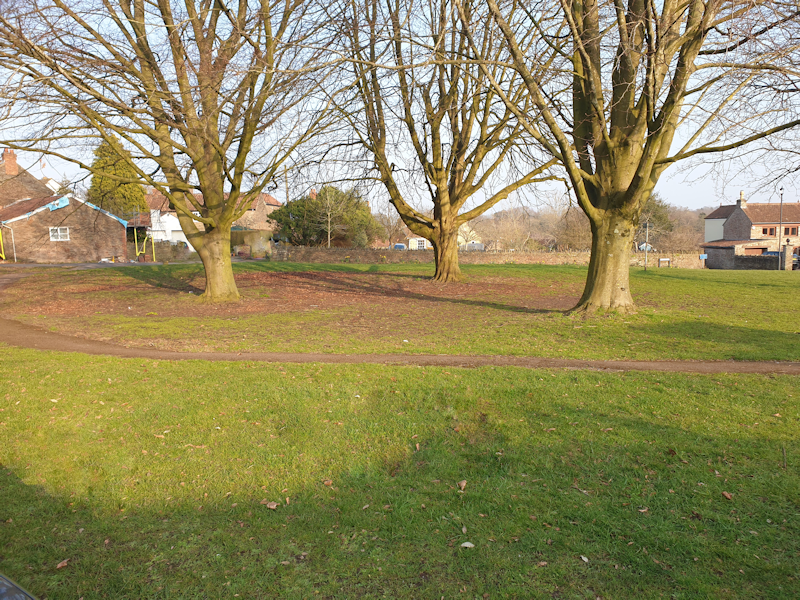
Small Common
The circular green was quite a deep quarry with a steep face on the northern (churchyard) which had a spring at its base. Men made a living from touring the area fetching water from the many springs for different laundries.
It is registered Common Land. It is surrounded by mainly 18th and 19th century cottages on three sides and is registered as part of Frenchay Common with the Commons Registration Authority.

Tuckett Field
The land known as Tuckett Field was given to the village by a bequest as an open informal space to be enjoyed in perpetuity by locals and others alike. Frenchay is particularly indebted to Francis Tuckett (1803-1868) who owned this open space and replaced the hedge with a sunken wall and ditch, known as a ha-ha, to open up the magnificent vista across to the woods on the other side of the river Frome.
His son, Francis Fox Tuckett (1834-1913) left the saddleback field, as it was then known, to the people of Frenchay for their enjoyment in perpetuity.
It is particularly visually attractive with the neighbouring Frenchay Moor giving it a rural aspect and feel. It is, along with The Moor, frequently occupied by grazing cattle which enhances the countryside aspect even further.
The Tuckett family played a significant part in the life of Frenchay Village and were great benefactors, hence the name Tuckett Field. The influence of the Tuckett family also left a mark on this landscape with the creation of an ornamental pond surrounded by holm oak. Another historically distinctive feature is the large stone marking the grave of the family pet pony encircled by a group of 5 Scots pines planted to signify the Tuckett children who lived at Frenchay Manor House.
Because of its geographical nature this space is unsuitable for formal recreation. It is, however, used by all the local community for dog walking, jogging and walking. Locally it is often known as the Hillyfield and in winter when the snow arrives, the local children use the slopes as a toboggan run.
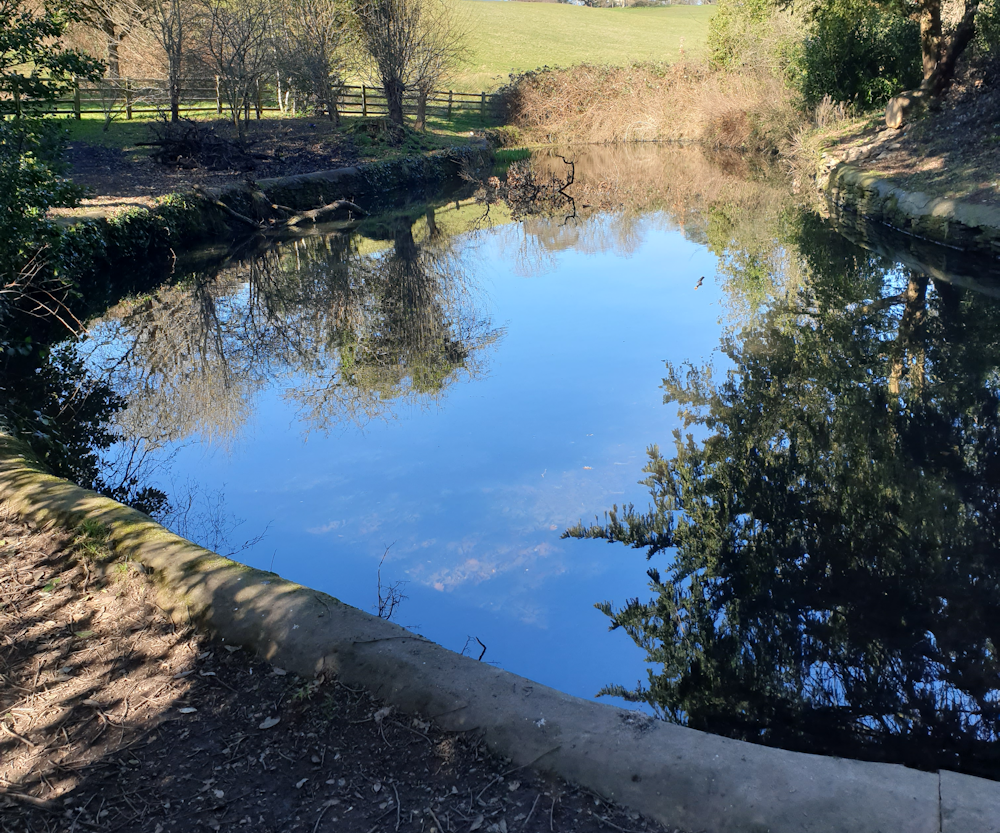
Tuckett Pond
This was restored by Winterbourne Parish Council around 25 years ago with the inner walling and fence. The water flows in through the field fed by springs via a ‘runnel’ at the V low section into the field into the pond.
The overflow goes out into the Frome through the lower fields. The pond itself was planned to be a landscape feature of a house for the Tuckett Family to be built on this low section of the moor but never came to be constructed.
Winterbourne Down & Hambrook
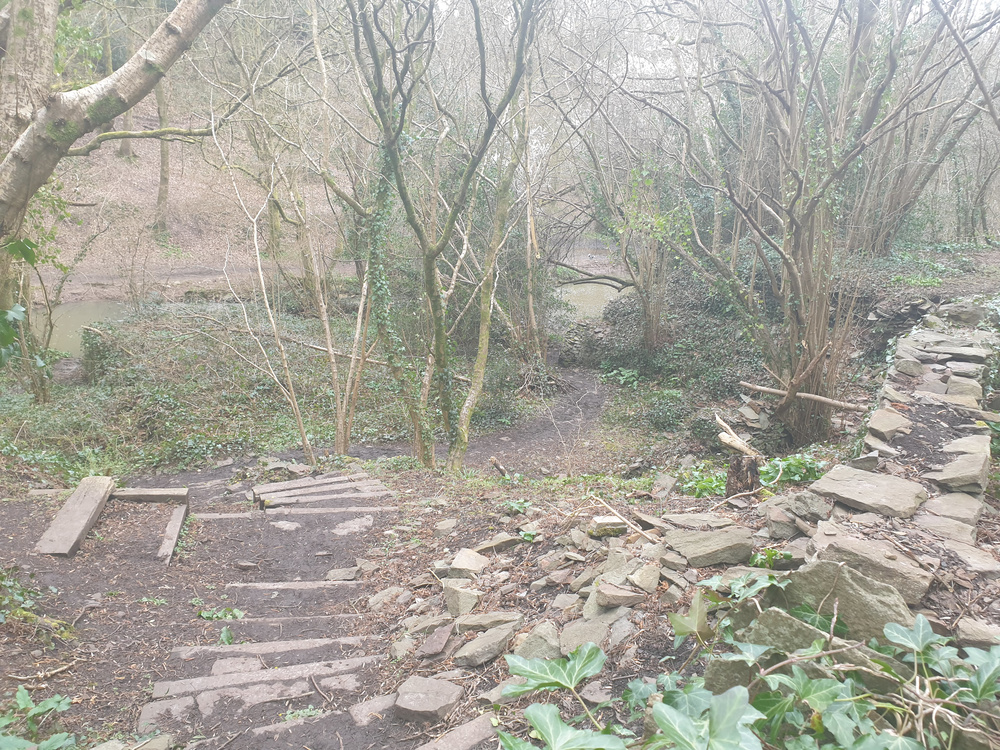
The Dingle
Winterbourne Parish Council own part of the land in the Dingle. It was bought to give some management to the land, and a working party helps clear the unwanted scrub land and provide sites for picnics and fishing. Native species of trees grow there, hornbeam, bird cherry, and crab-apple. There are fine views across the river from one side to the other. On the Bury Hill side are many mature trees.
The Dingle is the name of the river valley alongside Winterbourne Down village and runs from Damson’s Bridge to Mill Bridge. It is a natural green lung on the edge of the
village dividing the village from Bury Hill, the site of a Roman camp. The river Frome long distance walk from source to Bristol runs through it.
At one time it frequently flooded, but does so less now since the construction of a control dam at Iron Acton. Nevertheless the river still breaks its banks occasionally. High up on the village side of the river are cottages built with local pennant stone from the nearby quarries.
Long stretches of the river on both sides are supported by revetments of dry-stone construction. At the Mill Road end there used to be a mill, and some evidence of it still remains.
The area is a suitable habitat for a range of plants, many ferns (mostly harts-tongue), mosses and liverworts. Most of the flowering plants bloom in the spring before the tree canopy shades them out. Lesser celandine, garlic and wood anemones are abundant. The Dingle is also the home of many different species of birds including blue, long-tailed and great tits, song and mistle thrushes, blackbirds and robins. Occasionally kingfishers and grey wagtails can be seen. There are many species of invertebrates and two species of bat have been recorded. Recently otters are said to have returned.
The Frome river walk crosses the river half way along the Dingle giving public access to both sides. It is popular with both walkers from outside the area, and villagers, including children, as it represents a rare section of quite wilderness. The steepness of the hillsides on both sides makes it an area unsuitable for development and would deprive residents of a much-loved amenity.
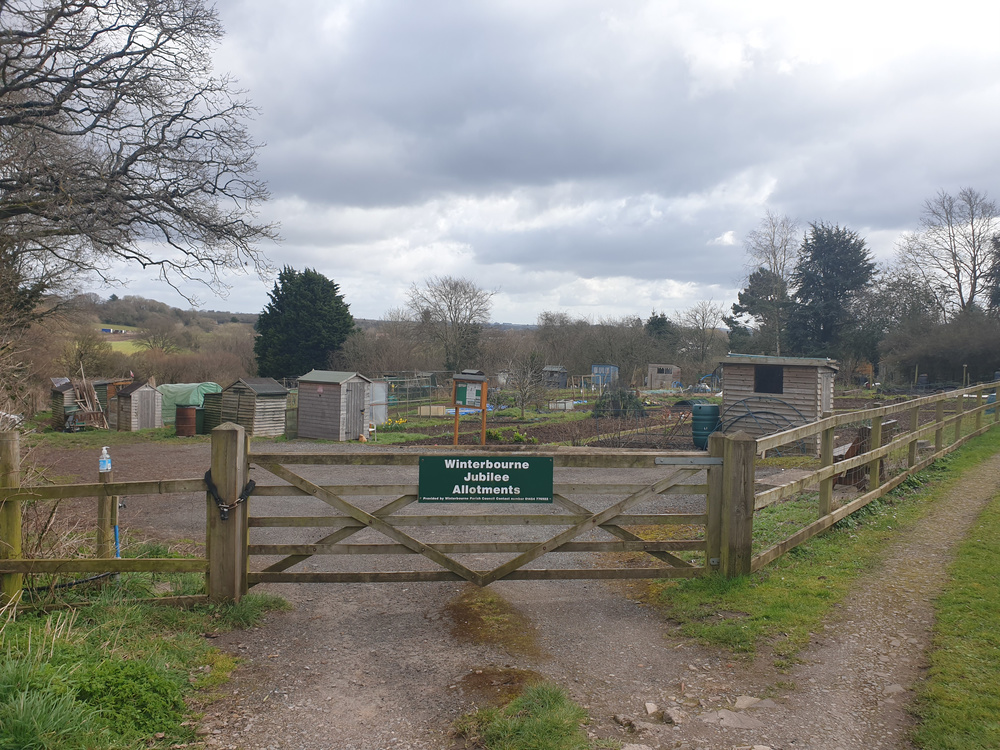
Jubilee Allotments
The area was used as a ‘Market Garden’ for at least 100 years before being converted into thirty allotments.
Winterbourne Parish Council purchased the land to create much needed allotments for use by the local community. An area of the allotments have a natural Woodland area to encourage wildlife, birds, insects and wild flowers. A local beekeeper keeps several beehives on the margins of the site.
The allotments are managed on a day to day basis by a management committee comprising Parish Councillors and allotment users. A natural spring is used to provide water to the allotments.
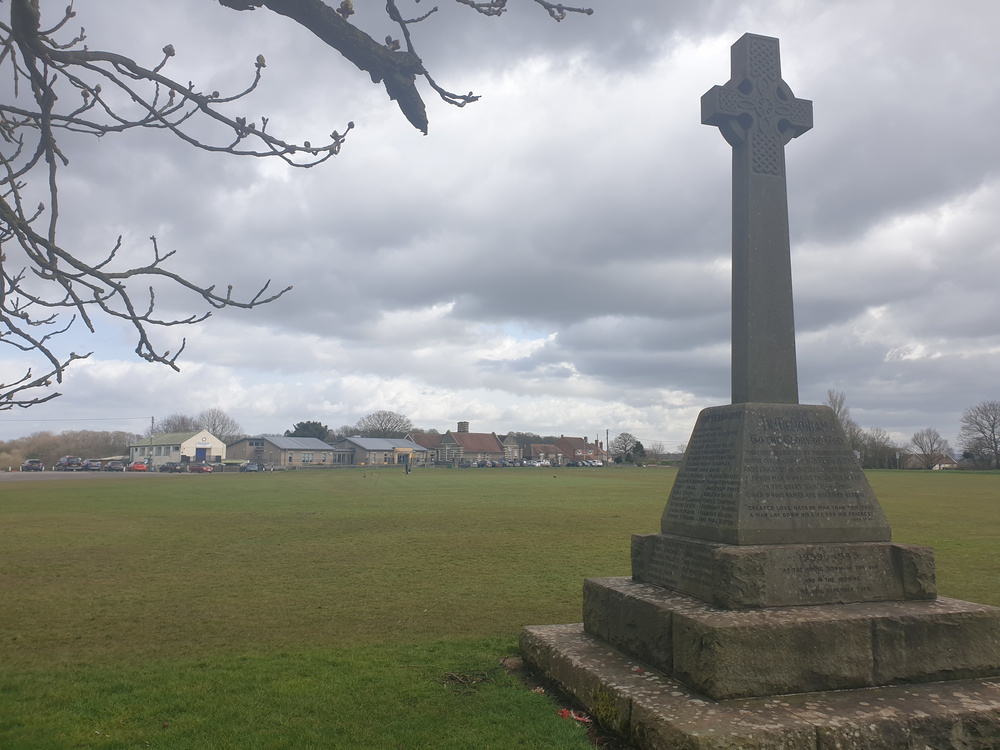
Whiteshill Common
Prior to the eighteenth century much of the land in Winterbourne and Hambrook was common land over which several owners of property held grazing rights, which were granted to tenants.
Records show that in 1779 concern was expressed that considerable parts of Winterbourne Common had been enclosed. Attempts were made to evict those who had taken over sections of Common land and (usually) built cottages on it. In 1825 an Enclosure Act was passed giving an amnesty where land had been enclosed for more
than twenty years. The Act specifically excluded Whiteshill Common, which was to remain Common Land.
The lords of Westerleigh, who owned it, later conveyed Whiteshill Common into the control of Winterbourne Parish Council. It has remained a common, open to the public for recreation and sport ever since.
It has been used by the local community for as long as any resident can remember and is still being used. It is bordered by Hambrook Primary School.
Hambrook Primary School does not have it’s own playing fields so Whiteshill Common is used for all their recreation and sport, particularly their sports day.
The Hambrook Commons Committee comprising the Parish Council, Hambrook Football Club and Hambrook Cricket Club manage the day to day management of Whiteshill Common.
Hambrook Football Club and Hambrook Cricket Club use it with the permission of the Parish Council and in return keep it cut and generally looked after. This has enabled Whiteshill Common to remain a beautiful open space for local people, including children, to enjoy.
Whiteshill Common stands in the centre of the communities of Hambrook, Winterbourne Down, and Winterbourne and is a well-loved amenity. There are benches for people to sit on and plenty of grass for joggers and walkers.
Whiteshill Common is the site of the local War memorial.
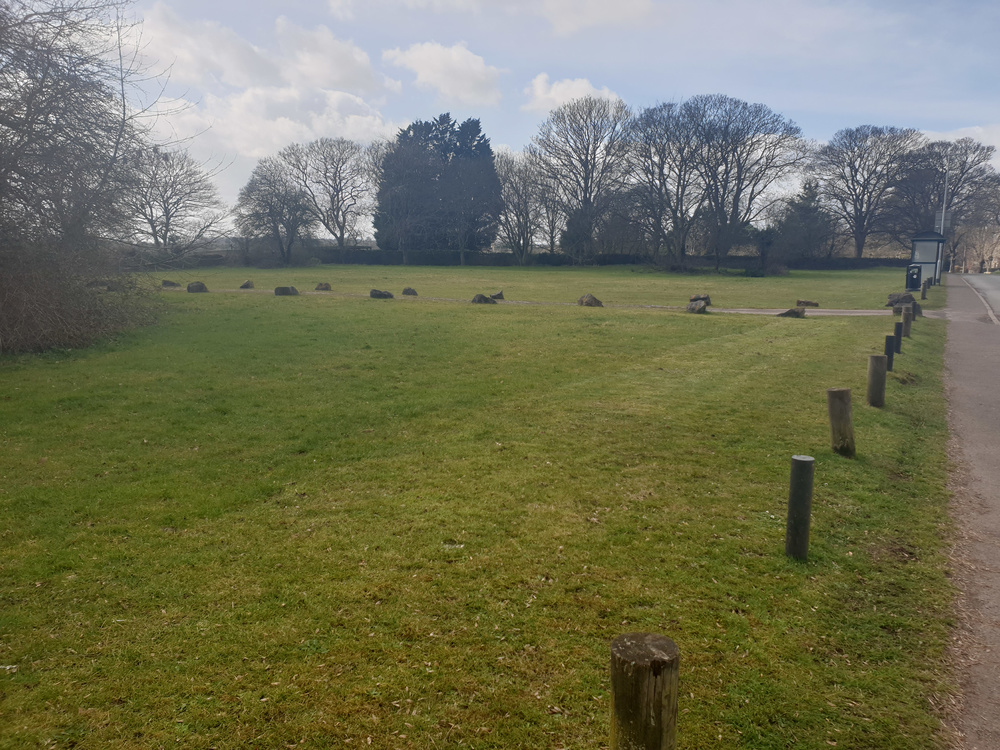
The Small Common
The Small Common Area was originally part of the main Whiteshill Common but was 'separated' by a very narrow but well used road. The use of the area is more associated with non-sport activities due to its size and shape.
Its regularly used for walking and limited horse activities. The Small Common is managed by the Hambrook Commons Committee.
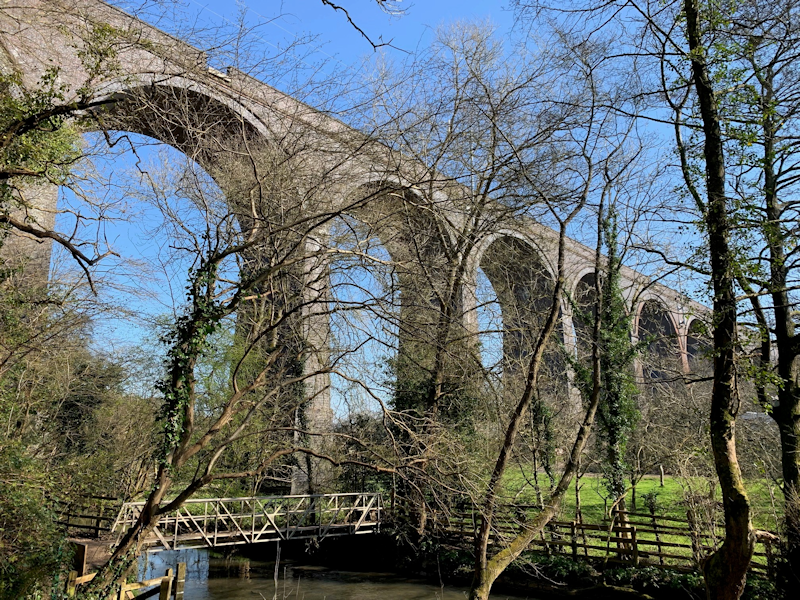
Huckford Quarry
Huckford Quarry is a nature reserve that sits on one edge of the high section of land between the River Frome and the Bradley Brook.
It is a steep hill of pennant sandstone which was regarded as good building material. A number of stone quarries were opened around the Winterbourne Down area from the sixteenth century onwards and many local cottages are built of pennant stone.
With the coming of the railways, a viaduct across the Frome was built adjacent to the
quarry which provided the stone for the core of brick-faced viaduct piers. As the building of the railway progressed, a vertical scar was left in the hillside which is there to this day.
The stone quarrying continued in the Huckford Quarry until about 1940 but its discontinuance left a sheer cliff face and slopes covered in fragments of rock. What is left is an almost enclosed nature reserve, its open side facing the river Frome. It is visible for those walking the Frome Valley footpath from the river’s source to Bristol.
Following its closure, the quarry was left for nature to reclaim it. Despite a lot of the quarry floor being rock, fern grows from the rock-face and around the rim trees remained. Where the ground was damp, harts tongue fern established itself together with other ferns and mosses. On some of the slopes birch took root.
The site was acquired by South Gloucstershire Council many years ago. The general policy has been to allow the quarry to re-establish itself naturally. This has happened although ash and sycamore seedlings needed some active control.
Safety was recognised as important and some paths were moved away from vertical drops and steps introduced on steep climbs. At a few locations barriers were erected to prevent people falling into the quarry.
Gradually nature has taken over, shrubs such as hazel, hawthorn and holly. Small colonies of wild flowers survived throughout the quarrying years and appear each spring. They include wood spurge and red campion, bugle, and wood anemone. A wildflower survey has been carried out every three or four years. Occasionally trees fall tearing gaps in the tree cover and rank vegetation crowds out the flowers. Foxglove is one species that struggles to survive. The site is becoming greener and richer but with fewer colourful flowers. Oak, ash and sycamore are to be found but not in abundance.
It is the wish of the local authority that the quarry continues to regenerate as naturally as possible, within the needs of safety and proper management. Being adjacent to the river Frome and the Frome valley walkway it has no access except on foot. It has no development potential and should be retained as a site of natural beauty for villagers and walkers to enjoy exploring.
Winterbourne
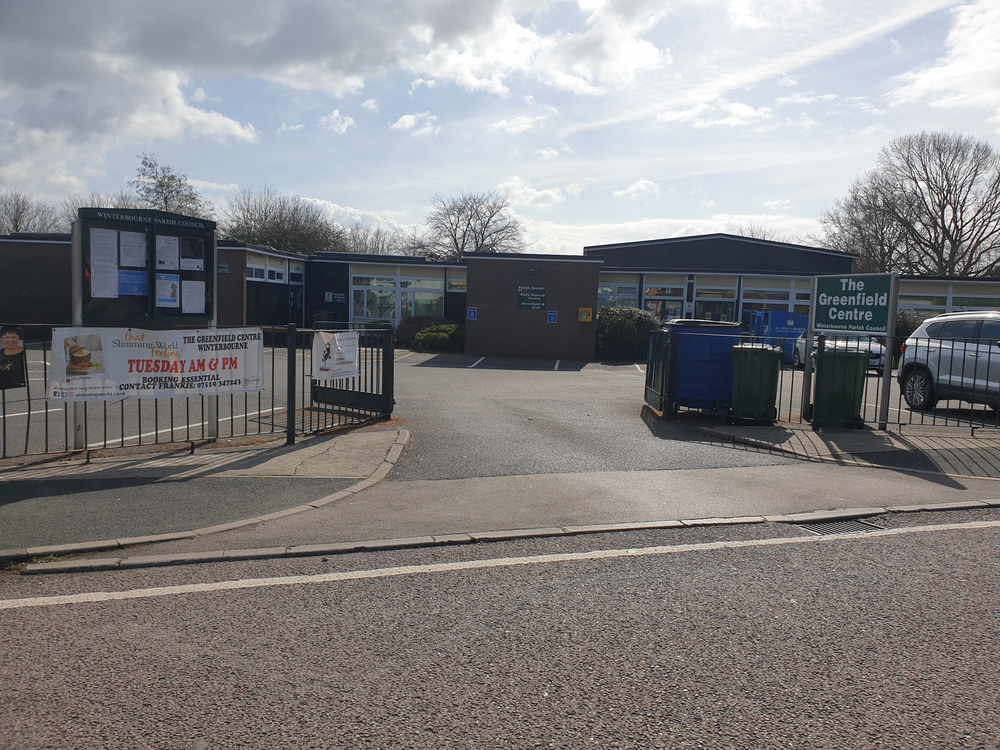

The Greenfield Centre
The Greenfield Centre is owned and operated by Winterbourne Parish Council. It is the home of the Parish Council offices and hosts various Parish Council meetings.
There is a large hall and two meetings rooms that are available for hire. These are used by a range of local clubs and societies and provide many different activities for local residents.
A well equipped and popular outdoor children’s play area.
The Greenfield Centre is also home to the Local Police Beat Team office, The Greenfield Club and Winterbourne Early Years Centre.
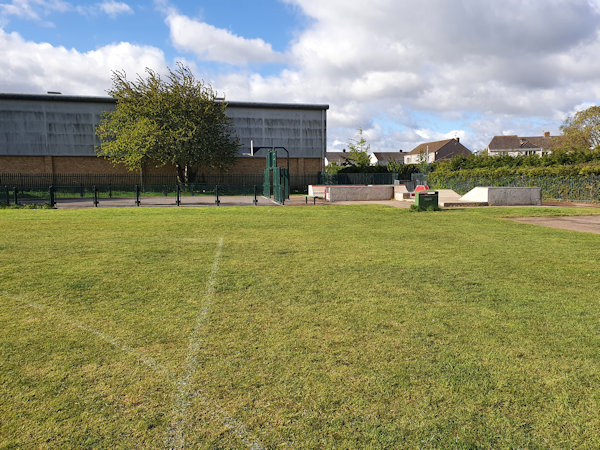
The Recreation Field
The land was originally owned by the Church Commissioners. It subsequently passed to the Local Authority and then to Winterbourne Parish Council.
The Recreation Filed is the home of Winterbourne United Football Club, Winterbourne Cricket Club, and Winterbourne Tennis Club. It accommodates a football pitch, cricket pitch 3 tennis courts, five a side enclosed football area with basketball provision and outdoor fitness equipment.
Over 400 adults and juniors regularly use the organized sports facilities whilst hundreds of local residents use the land for walking, jogging and walking their dogs.
There is a well appointed pavilion that provides changing and catering facilities.
The recreation field is managed by the Winterbourne Sports Association consisting of representatives from Winterbourne Cricket Club, Winterbourne United Football Club, Winterbourne Tennis Club and Winterbourne Parish Council.
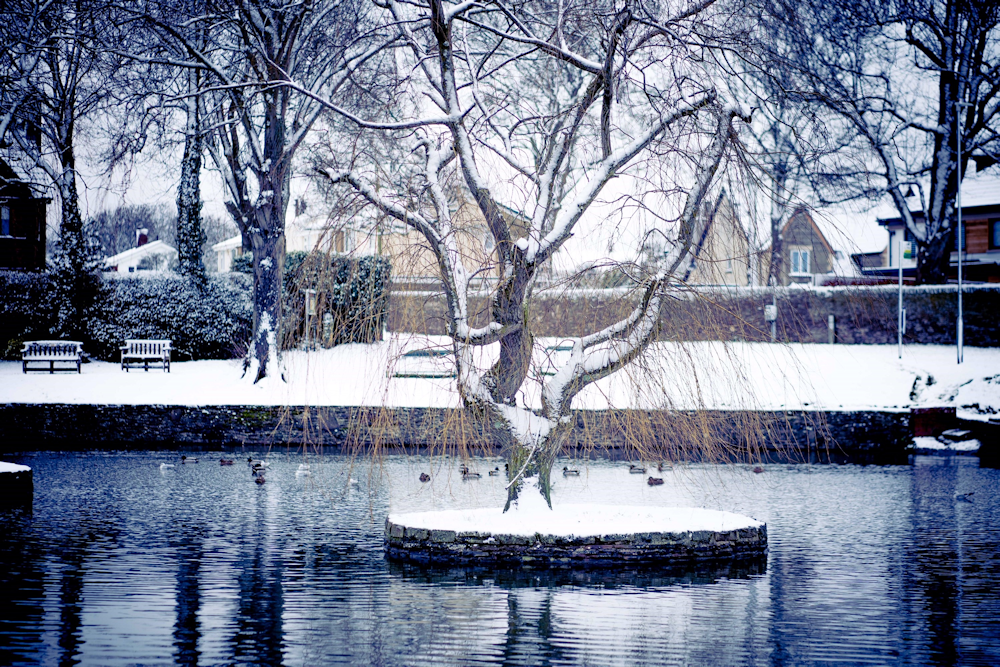
Duck Pond
The duck pond, also known as Flaxpits Pond, has been a beautiful peaceful oasis in the middle of Winterbourne for many generations.
It has existed since the 16th century when it was used to soak flax before making linen, so is of considerable historic significance.
The area is used by local residents of all ages as a place for recreation and is very popular with local fishermen.
Winterbourne Parish Council own the pond and maintain the surrounding area. Frome Valley Angling Club manage the ‘water’ and fishing on behalf of the Parish Council.
In line with the Aquatic Animal Health (England and Wales) Regulations 2009 The Pond is registered with the Fish Health Inspectorate (FHI) based at the Centre for Environment, Fisheries and Aquaculture Science (Cefas).
From 16th June 2016 you must be a member of the Frome Valley Angling Club to fish in this pond and abide by thier rules relating to this water.
Frome Valley Angling Membership
If you wish to fish in this pond and are not a current member of the Frome Valley Angling Club please email Nigel Vigus:
Please do contact clerk@winterbournepc.co.uk if you do not get a response in a couple of weeks.
Environment Agency Rod License
In addition to this all anglers ages 12 or over must hold a current Fishing Rod License.
A license can be brought from online: https://www.gov.uk/fishing-licences/buy-a-fishing-licence (please copy and paste this link) or call the Enviroment Agency on 0344 800 5386 (Monday - Friday 8am - 6pm)
We have a fishing ban for the month of May and also no roadside fishing in June.
During the last decade new areas to the margins have been created and planted with bullrush and willow and these form the homes for a variety of wild fowl and other wild life which have become a much loved village feature.
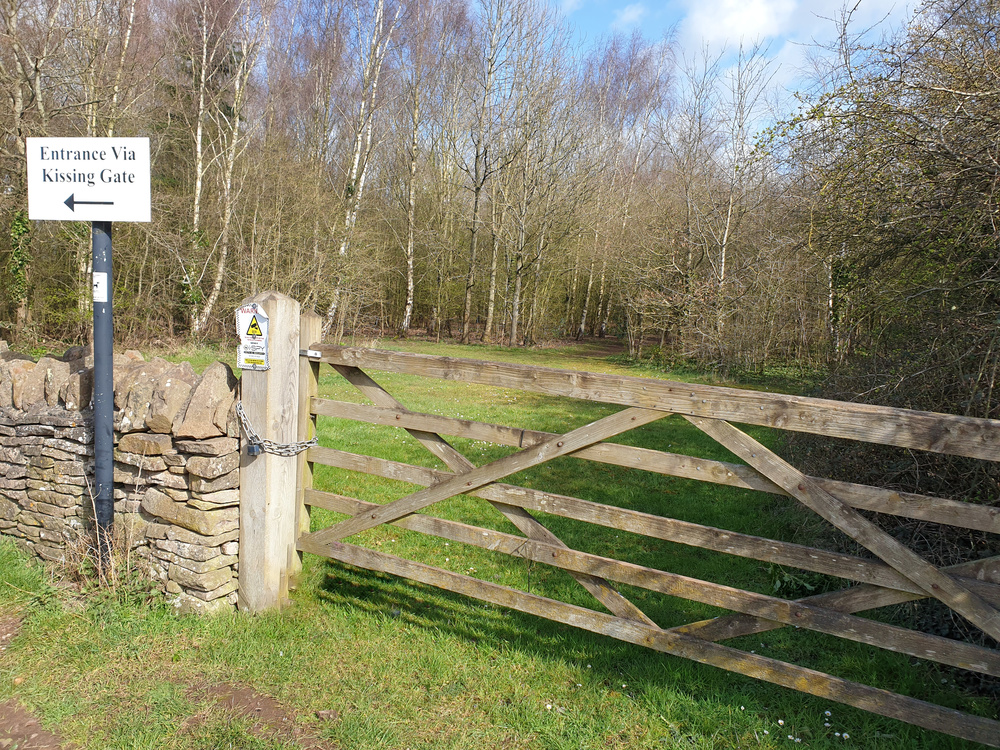
Newleaze Community Woodland
Winterbourne Parish Council purchased the land with the intention of creating a much needed new community woodland in an area of the village where no similar facilities existed.
Newleaze Community Woodland was originally planted in 1998 to create an oak/birch woodland at its core and to include other trees around its perimeter.
It was recognised that a woodland amenity site close to the village of Winterbourne would be able to bring the natural world closer to residents.
It has a pond and is abundant with wildlife, a nature trails within and is used by local schools to make children of all ages aware of nature. Newlaze is regularly used by local residents for walks, picnics and similar recreation activities.
A group of highly experienced volunteers manage the upkeep of the area maintaining the wide range of trees and flora. The site is used as a nesting site for owls and accommodates special nesting boxes provided by the Hawk and Owl Trust whilst other fauna use the pond margins and adjoining rhyne as a home.
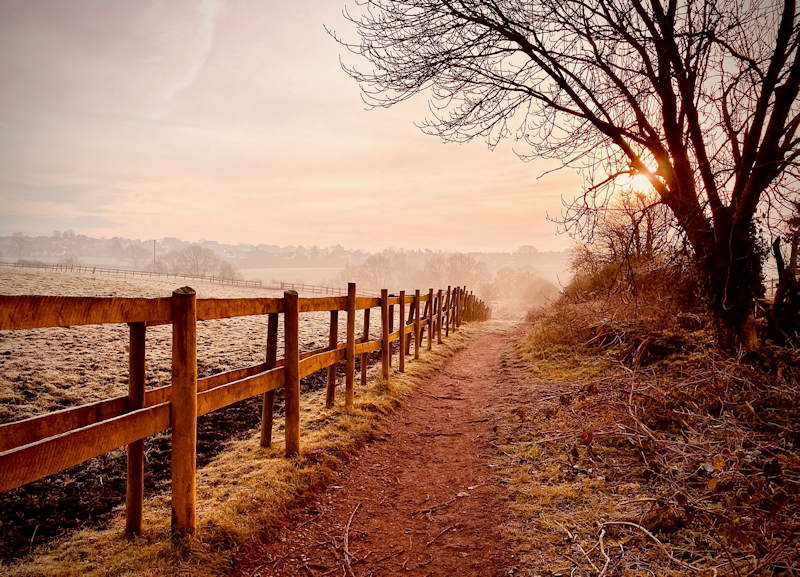
Monks Pool
Monks Pool is owned by South Gloucestershire Council and managed by Winterbourne Parish Council and is one of several Local Nature Reserves that Winterbourne Parish Council manage for the benefit of parishioners and other local residents.
It is used by a wide variety of people as a place for leisure and a place for learning. Schools, pre-schools and other students use the site for study and research. Monks Pool is of particular historic significance.
The Winterbourne Medieval Barn was originally part of Winterbourne Court Farm. The farm was the home of Carmelite Friars in the 13th Century. The area known as Monks Pool borders Winterbourne Court Farm. Hence the name was given to these medieval pools that were thought to have been stocked with fish in the middle ages.
Other histories of the area suggest the pools were used as fishponds for the benefit of the medieval Manor House or for the benefit of priests and travellers on their journeys between Bristol and Gloucester.
A group of highly experienced volunteers manage the upkeep of the area maintaining the historic range of trees and flora. The site is used as a nesting site for owls and accommodates special nesting boxes provided by the Hawk and Owl Trust whilst other fauna use the adjoining river banks as a home.
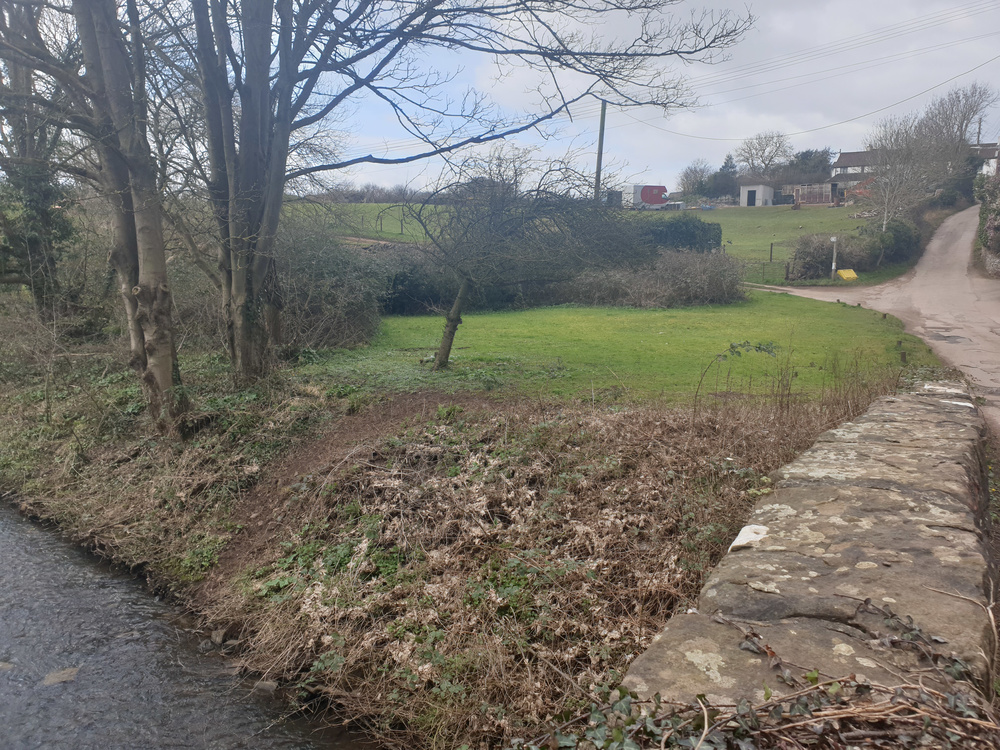
Bradley Brook
Bradley Brook is one of several Local Nature Reserves that South Gloucestershire Council Own and Winterbourne Parish Council manages for the benefit of parishioners and other local residents. It is used by a wide variety of people as a place for leisure and a place for learning. Schools, pre-schools and other students use the site for study and research.
Bradley Brook is a particularly attractive area and is a feature of the Frome Valley Walkway.
It is said that the village of Winterbourne owes its name to the Bradley Brook, which joins the river Frome in the village. It was claimed that the stream dried up in summer and for that reason was known as a winter bourne, an old English term for a stream that dries up in summer. 'The Bradley Brook' river runs through the Bradley Brook nature reserve.
A group of highly experienced volunteers manage the upkeep of the area maintaining the wide range of trees and flora. The site is used as a nesting site for a wide number of woodland and river birds including Kingfishers. Many woodland fauna live within this small woodland whilst others the adjoining river banks as a home.
Winterbourne Parish Council
The Greenfield CentrePark Avenue
Winterbourne
Bristol
BS36 1NJ
T. 01454 776922
Send us an email
Important Links

